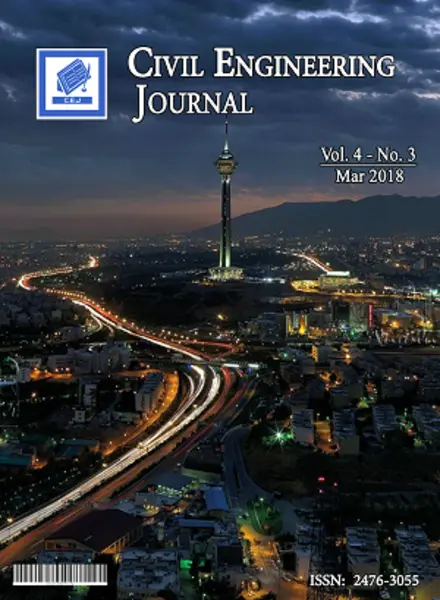-
development of soil distribution and liquefaction potential maps for downtown area in yangon, myanmar
جزئیات بیشتر مقاله- تاریخ ارائه: 1400/08/01
- تاریخ انتشار در تی پی بین: 1400/08/01
- تعداد بازدید: 567
- تعداد پرسش و پاسخ ها: 0
- شماره تماس ژورنال: 982188779475ext.258
the problem of soil against liquefaction during earthquakes is devastating geotechnical phenomenon. soil against liquefaction is generally occurred in loose cohesionless saturated soil when pore water pressure increases suddenly due to earthquakes and shear strength of the soil decreases to zero. yangon area has been chosen as the study area because it is the most populated and largest city in myanmar and located in low to medium seismicity region. in this purpose, the liquefaction potential map have been prepared for site planners and decision makers to prevent loss of lives. geographic information system (gis) is very useful in decision making about the area subjected to liquefaction. arcgis software is used to develop the liquefaction potential maps of the selected area in yangon city. to perform in this study, the field borehole data for groundwater table, standard penetration test (spt), blow counts, dry density, wet density and fine content, etc. have been collected from the downtown area of this city. firstly, the safety factor of soil liquefaction is computed by using nceer (national center of earthquake engineering research, 1997) method based on cyclic resistance ratio and cyclic stress ratio and then liquefaction potential index (lpi) values are determined using luna and frost method, 1998. finally, liquefaction potential maps are developed corresponding to the ground motions for annual probability of exceedance equal to 1%, 2% and 10% in 50 years.
حوزه های تحت پوشش ژورنال
مقالات جدیدترین رویدادها
-
استفاده از تحلیل اهمیت-عملکرد در ارائه الگوی مدیریت خلاقیت سازمانی و ارائه راهکار جهت بهبود
-
بررسی تاثیر ارزش وجوه نقد مازاد بر ساختار سرمایه شرکت های پذیرفته شده در بورس اوراق بهادار تهران
-
بررسی تأثیر سطح افشای ریسک بر قرارداد بدهی شرکت های پذیرفته شده در بورس اوراق بهادار تهران
-
بررسی تأثیر رتبه بندی اعتباری مبتنی بر مدل امتیاز بازار نوظهور بر نقد شوندگی سهام با تأکید بر خصوصی سازی شرکت ها
-
تأثیر آمیخته بازاریابی پوشاک ایرانی بر تصویر ذهنی مشتری پوشاک ایرانی (هاکوپیان)
-
چگونه توانستم دانش آموزان کلاس چند پایه را به رعایت نظم در کلاس ترغیب کنم؟
-
تخمین مکان چاه ها در مخازن نفت به کمک سیستم عصبی
-
آب و خاک
-
درآمدی بر مفهوم هویت در رویکرد باز آفرینی بافت های فرسوده ارزشمند شهری
-
assessment and developing methods to reduce evaporation from water reservoirs and dams
مقالات جدیدترین ژورنال ها
-
مدیریت و بررسی افسردگی دانش آموزان دختر مقطع متوسطه دوم در دروان کرونا در شهرستان دزفول
-
مدیریت و بررسی خرد سیاسی در اندیشه ی فردوسی در ادب ایران
-
واکاوی و مدیریت توصیفی قلمدان(جاکلیدی)ضریح در موزه آستان قدس رضوی
-
بررسی تاثیر خلاقیت، دانش و انگیزه کارکنان بر پیشنهادات نوآورانه کارکنان ( مورد مطالعه: هتل های 3 و 4 ستاره استان کرمان)
-
بررسی تاثیر کیفیت سیستم های اطلاعاتی بر تصمیم گیری موفق در شرکتهای تولیدی استان اصفهان (مورد مطالعه: مدیران شرکتهای تولیدی استان اصفهان)
-
بررسی تاثیر باورهای فراشناختی و نگرش مذهبی، برگرایش به مصرف سیگار در نوجوانان
-
بررسی رابطه تاب آوری و خودپنداره تحصیلی با مطلوبیت اجتماعی دانش آموزان پسر دوره دوم متوسطه شهرستان گنبدکاووس
-
الگوی شمایل نگاری شیعی با تکیه بر بررسی شمایل نگارانه نسخه خاوران نامه فرهاد نقاش
-
شخصیّت و شخصیّت پردازی در داستان بغض آینه اثر سیّدمهدی شجاعی
-
development of closed-circuit elastic mounting for working bodies in the interrow cultivator


سوال خود را در مورد این مقاله مطرح نمایید :